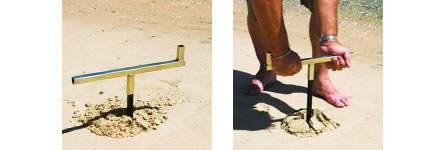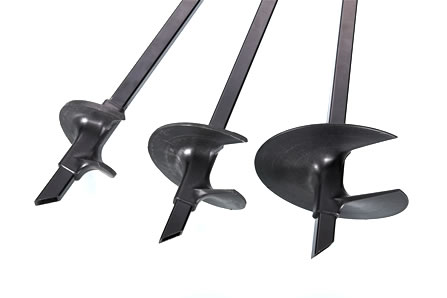The Wombat

What is a Wombat?
WOMBAT is manufactured by Rapid Anchor Pty Ltd. Some
people mistake the WOMBAT for a propeller but it’s a
strong fully engineered ground anchor. WOMBAT is a
re-usable lightweight shallow ground anchor,
manufactured using a coated mild steel or stainless
steel shaft and a composite material helix. As WOMBAT is
wound into the ground the helix pitch continually
expands clamping into the ground giving it greater
strength in shallow grounds.
It’s the World’s Strongest re-usable shallow ground
anchor. Research is now underway in to how this
technology can be used for compression piling as it has
significant cost advantages for the industry.
With WOMBAT you can anchor almost anything to the ground
quickly, either for temporarily or semi-permanently
applications. WOMBAT has the unique ability to resist
forces up to almost 1000 times its own weight.

WOMBATS are manufactured from coated carbon or stainless
steel shafts and have composite helix’s which are keyed
to the shaft during manufacture.
The steel shaft is used to enable the composite helix to
be wound into the ground effectively.
Depending on the model selected either heavy duty hollow
carbon or solid stainless steel is used in shaft
manufacture. Hot-dip galvanized carbon steel models are
available.
WOMBATS Patented Composite Helical Technology provides
an incredibly tough, durable and resilient holding
element.
Technical specifications
-
Shaft:
> Carbon Steel, specially formed heavy wall 16mm hollow square section (SHS) typically 600mm long.
> Carbon Steel, solid square 20mm merchant bar (SMB) in 600mm, 800mm, 1200mm lengths.
> Stainless Steel, solid square 20mm merchant bar (SMB) in 600mm, 800mm, 1200mm lengths. - Coatings: Anti-corrosive electroplating or galvanizing for carbon steels. Stainless steels are polished.
- Helix:composite complete with embossed cut-down diameters for differing soils
- Weight:From as little as 400g to 4.5kgs
- Strength:Holds up to 1200kg depending on model selection, soil condition and installation technique.
So how does it work?

As the composite helix is wound into the ground the helix "pitch" begins to expand. As it expands the pitch angle of soil entry and exit increases. This process forces additional soil through and around the vortex. As more soil is forced through the greater the pitch of the helical blades. The helix is manufactured from one of the world most resilient materials. This resilience tries to resist the increase in helical pitch angle. This action effectively compresses anything that passes through it. Due to soil mechanics it is so effective that it actually displaces compressed material to around the entire anchor. This action cannot be achieved by using steel helix’s. That’s why WOMBAT has such incredible holding power even a depths of 600mm in sand. That’s why WOMBAT is the world’s strongest shallow ground anchor.
How to Install

There are two methods: Use the detachable T-Bar comes with WOMBAT Kits and simply screwed into the ground and back out when you have finished with it. Or, use a high-powered drill and the WOMBAT Hex-drive socket & power adaptor that are sold separately. There is no need for big hammers or sledges and removal is just as easy as installation. The underside of the helix has 2 embossed circle lines along with soil descriptions. If you are using the WOMBAT is sand you don’t need to do anything. If the ground you are installing it into is stiff clay trim the helix down to the first line from the edge. If installation into road-base type material is required trim the helix to the smallest circle. Trimming is easy using a hacksaw, a small angle grinder, a cutter or snips. (Caution: Be careful of hot or melted plastic it may stick to your skin and burn. Always use the appropriate Personal Protection Equipment (PPE) such as goggles, gloves & footwear to avoid injury.)
Soil Types

WOMBAT was developed to maximize its expansive
technology and is primarily intended for use in sandy
conditions. It can be installed in soft firm or stiff
clays as well as hard ground such as road-base. dense to
very hard soil types by cutting down the helix size
using a hacksaw or cutting tool and following the cut
lines engraved on the helix underside.
Invented in Australia, this ingenious device is as tough
as the Australian marsupial “The Wombat” cheerfully
known as the “Bulldozer of the Bush”. It is common
knowledge that once a WOMBAT burrows underground there’s
no getting him out unless he want too! That’s why we
called our anchor the WOMBAT! Using the WOMBAT will
change the you way you tie or anchor objects to the
ground, above or below the waterline. This lightweight
reusable handy range products has so many uses. We
recently receive an email from a New Zealand farmer who
used it as a ground anchoring point during an emergency
calving berth in the middle of a paddock. Now that’s got
to be a first! Good on you Ralph.

